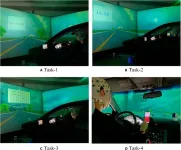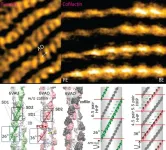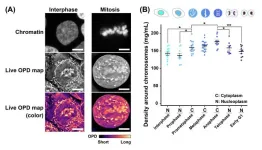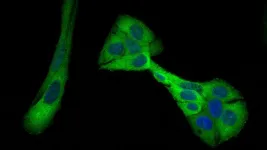(Press-News.org) More people in the UK are at risk of a hereditary form of cardiac amyloidosis, a potentially fatal heart condition, than previously thought, according to a new study led by researchers at UCL (University College London) and Queen Mary University of London.
The study, published in JAMA Cardiology, used data from the UK Biobank to analyse the genes of 469,789 people in the UK and found that one in 1,000 possessed genetic variants with a likely link to cardiac transthyretin (ATTR) amyloidosis.
Among study participants with African ancestry, incidence was much higher, with one in 23 (4.3%) having genes thought to be linked to the disease.
Cardiac amyloidosis is where abnormal proteins, called amyloid, build up in the heart tissue, making the heart stiff and less able to pump blood. If left untreated, it is likely to be fatal within four to six years.
Senior author Dr Luis Lopes, from the UCL Institute of Cardiovascular Science, said: “We found a higher than expected number of people in the UK with potentially harmful genetic variants linked to cardiac ATTR amyloidosis, an often fatal condition.
“Many people with these variants will not go on to develop disease. However, it is important to try to identify those who do as early as we can, as there are promising new medicines that can effectively treat the condition, and acting earlier with these medicines is likely to help patients more.”
The first author, Dr Nay Aung, from the William Harvey Research Institute, Queen Mary University of London, said: “Our study showed that people carrying these potentially harmful variants have a two-to-three-fold increase in the risk of heart failure and cardiac rhythm issues. This again highlights the need for early detection and monitoring for disease progression.”
Previously, ATTR amyloidosis was considered rare, affecting between one in 120,000 and one in 830,000 people globally. In recent years in the UK, however, the number of people being diagnosed has increased, partly due to improvements in imaging pioneered at the UCL Centre for Amyloidosis.
ATTR amyloidosis can be hereditary, caused by a mutation in the transthyretin (TTR) gene, but it can also occur as people age without a genetic basis.
The hereditary form is known to be much more common in certain geographic clusters of populations in Portugal, Japan and Sweden, and among individuals with Black African ancestry.
The new study, in contrast to previous research looking at the prevalence of one genetic variant linked to ATTR amyloidosis (Val142Ile), estimated the prevalence of 62 variants identified as having a possible link to the disease.
Looking at an average of 12 years of data from the UK Biobank participants, the research team found that people with these variants had a higher risk of heart failure, thickening of the heart muscle, and heart rhythm problems, which held true after adjusting for factors such as age, sex, BMI and cardiovascular risk factors.
Hospital data suggested a relatively low proportion, 2.8%, of this group had been diagnosed with cardiac amyloidosis. The UK Biobank participants were aged 57 on average and the researchers said the disease may develop later in life or still be in its earliest stages during the time of the study.
The proportion doubled when researchers looked for extra-cardiac symptoms associated with the hereditary form of ATTR amyloidosis, suggesting under-recognition of the disease in its early stages.
These symptoms included carpal tunnel syndrome (pressure on a nerve in your wrist causing tingling, numbness and pain in your hand and fingers) and lumbar stenosis (the narrowing of the area of the spine that contains the nerves or spinal cord, leading to aching, cramping and tingling in the legs brought on by walking or standing).
The researchers called for greater clinical vigilance for possible hereditary ATTR amyloidosis among people with these symptoms or with unexplained thickened heart muscle.
A next step, the researchers said, would be to prospectively investigate the proportion of people with these variants who developed disease. This could help to inform possible screening strategies. Genetic tests are currently offered to people with symptoms or people whose family members have the disease.
Among the promising new treatments for ATTR amyloidosis is a gene-editing therapy developed at the UCL Centre for Amyloidosis. Early trial results of the therapy, a single intravenous infusion of NTLA-2001, indicate it may stop disease progression.
The therapy is one of several new treatments that aim to tackle the amyloid build-up on the heart. Previously, treatments for the condition sought to relieve the symptoms of heart failure (which may include fatigue, swelling in the legs or abdomen, and shortness of breath with activity), but did not address the underlying cause.
The researchers received funding from the Medical Research Council, the European Union’s Horizon 2020 programme, Queen Mary University of London, the National Institute for Health and Care Research (NIHR) UCLH and Barts Biomedical Research Centre, Barts Health NHS Trust, St George’s University Hospitals NHS Foundation Trust and St George’s University of London.
END
More people at risk of hereditary heart disease than thought
More people in the UK are at risk of a hereditary form of cardiac amyloidosis, a potentially fatal heart condition, than previously thought, according to a new study led by researchers at UCL and Queen Mary University of London.
2024-08-28
ELSE PRESS RELEASES FROM THIS DATE:
Breaking open the AI black box, team finds key chemistry for solar energy and beyond
2024-08-28
CHAMPAIGN, Ill. — Artificial intelligence is a powerful tool for researchers, but with a significant limitation: The inability to explain how it came to its decisions, a problem known as the “AI black box.” By combining AI with automated chemical synthesis and experimental validation, an interdisciplinary team of researchers at the University of Illinois Urbana-Champaign has opened up the black box to find the chemical principles that AI relied on to improve molecules for harvesting solar energy.
The result produced light-harvesting molecules four times more stable than ...
Discovery of how blood clots harm brain and body in COVID-19 points to new therapy
2024-08-28
In a study that reshapes what we know about COVID-19 and its most perplexing symptoms, scientists have discovered that the blood coagulation protein fibrin causes the unusual clotting and inflammation that have become hallmarks of the disease, while also suppressing the body’s ability to clear the virus.
Importantly, the team also identified a new antibody therapy to combat all of these deleterious effects.
Published in Nature, the study by Gladstone Institutes and collaborators overturns the prevailing ...
JAMA review highlights advances in kidney cancer research and care
2024-08-28
CHAPEL HILL, North Carolina — New insights into the biology of kidney cancer, including those informed by scientific discoveries that earned a Nobel Prize, have led to advances in treatment and increased survival rates, according to a review by UNC Lineberger Comprehensive Cancer Center’s William Kim, MD, and Tracy Rose, MD, MPH.
Their observations, drawn from a meta-analysis of 89 studies published between January 2013 and January 2024, were published in JAMA Aug. 28.
“The Nobel Prize in Medicine or Physiology in 2019 was awarded ...
new diabetes research in Scientific Reports links blood glucose levels and voice
2024-08-28
NEW YORK/TORONTO – August 28, 2024 – As part of its ongoing exploration of vocal biomarkers and the role they can play in enhancing health outcomes, Klick Labs published a new study in Scientific Reports today – confirming the link between blood glucose levels and voice pitch and opening the door to future advancements in non-invasive glucose monitoring for people living with Type 2 diabetes.
In “Linear Effects of Glucose Levels on Voice Fundamental Frequency in Type 2 diabetes and Individuals with Normoglycemia,” researchers ...
Augmented recognition of distracted driving state based on electrophysiological analysis of brain network
2024-08-28
A research paper by scientists at Beijing Jiaotong University proposed an electrophysiological analysis-based brain network method for the augmented recognition of different types of distractions during driving.
The new research paper, published on Jul. 04 in the journal Cyborg and Bionic Systems, designed and conducted a simulated experiment comprising 4 distracted driving subtasks. Three connectivity indices, including both linear and nonlinear synchronization measures, were chosen to construct the brain network. By computing connectivity strengths and topological features, we explored the potential relationship between brain network configurations and states ...
The functions of actin-binding proteins are regulated by the flexibility and specific helical twists of actin filaments
2024-08-28
Researchers at Kanazawa University report in eLife on deciphering the actin structure-dependent preferential cooperative binding of cofilin.
The actin filament is a double-stranded helical structure formed by intertwining two long-pitch helices, with the distance between crossover points, known as the half helical pitch (HHP), being about 36 nm. A canonical half helix consists of 13 actin protomers, or 6.5 protomer pairs, resulting in a mean axial distance (MAD) of 5.5 nm between two adjacent protomers ...
Team discovers transient rise in depletion attraction contributes to mitotic chromosome condensation
2024-08-28
A team of scientists studying cell division developed a special light microscopy system and used it to analyze the molecular density of cellular environments. Their results provide a novel insight into mitotic chromosome condensation in living human cells.
Their work is published in the journal Proceedings of the National Academy of Sciences (PNAS) on August 27, 2024.
DOI:https://doi.org/10.1073/pnas.2403153121
To carry out their study, the team developed an orientation-independent-differential interference contrast (OI-DIC) microscopy system combined with a confocal ...
nTIDE Deeper Dive August 2024: Disability Employment Disparities Among Students: High School Struggles, College Advancement
2024-08-28
East Hanover, NJ – August 28, 2024 – Young people with disabilities aged 16 to 24 had high school enrollment rates nearly identical to their non-disabled peers, but significantly fewer held jobs during this time. Meanwhile, college students with disabilities were less likely to be enrolled but were slightly more likely to be employed, possibly benefiting from the rise of remote work opportunities in the post-COVID era, according to data shared during the according to last Friday’s National Trends in Disability ...
Rain or shine? How rainfall impacts size of sea turtle hatchlings
2024-08-28
Female sea turtles lay their eggs, cover the nest with sand and then return to the ocean, leaving them to develop and hatch on their own. From nest predators to rising temperatures, odds of survival are bleak. Once hatched and in the ocean, about one in 1,000 make it to adulthood.
Hatchling size matters. Larger hatchlings, which move faster, are more likely to survive because they spend less time on risky beach sands.
Research shows that both air and sand temperatures crucially impact sea turtle hatchlings. Cooler temperatures produce larger, heavier hatchlings with more males, while warmer temperatures ...
How breast cancer goes hungry
2024-08-28
Cancer cells have voracious appetites. And there are certain nutrients they can’t live without. Scientists have long hoped they might stop tumors in their tracks by cutting off an essential part of cancer cells’ diet. But these cells are crafty and often find a new way to get what they need. How? By reprogramming their metabolism and switching to backup food supplies.
Now, Cold Spring Harbor Laboratory (CSHL) Assistant Professor Michael Lukey has found a way to deprive cancer cells of both a vital nutrient and their backup supply. In lab experiments with breast cancer cells, patient-derived tissue models, and mice, ...
LAST 30 PRESS RELEASES:
Making lighter work of calculating fluid and heat flow
Normalizing blood sugar can halve heart attack risk
Lowering blood sugar cuts heart attack risk in people with prediabetes
Study links genetic variants to risk of blinding eye disease in premature infants
Non-opioid ‘pain sponge’ therapy halts cartilage degeneration and relieves chronic pain
AI can pick up cultural values by mimicking how kids learn
China’s ecological redlines offer fast track to 30 x 30 global conservation goal
Invisible indoor threats: emerging household contaminants and their growing risks to human health
Adding antibody treatment to chemo boosts outcomes for children with rare cancer
Germline pathogenic variants among women without a history of breast cancer
Tanning beds triple melanoma risk, potentially causing broad DNA damage
Unique bond identified as key to viral infection speed
Indoor tanning makes youthful skin much older on a genetic level
Mouse model sheds new light on the causes and potential solutions to human GI problems linked to muscular dystrophy
The Journal of Nuclear Medicine ahead-of-print tip sheet: December 12, 2025
Smarter tools for peering into the microscopic world
Applications open for funding to conduct research in the Kinsey Institute archives
Global measure underestimates the severity of food insecurity
Child survivors of critical illness are missing out on timely follow up care
Risk-based vs annual breast cancer screening / the WISDOM randomized clinical trial
University of Toronto launches Electric Vehicle Innovation Ontario to accelerate advanced EV technologies and build Canada’s innovation advantage
Early relapse predicts poor outcomes in aggressive blood cancer
American College of Lifestyle Medicine applauds two CMS models aligned with lifestyle medicine practice and reimbursement
Clinical trial finds cannabis use not a barrier to quitting nicotine vaping
Supplemental nutrition assistance program policies and food insecurity
Switching immune cells to “night mode” could limit damage after a heart attack, study suggests
URI-based Global RIghts Project report spotlights continued troubling trends in worldwide inhumane treatment
Neutrophils are less aggressive at night, explaining why nighttime heart attacks cause less damage than daytime events
Menopausal hormone therapy may not pose breast cancer risk for women with BRCA mutations
Mobile health tool may improve quality of life for adolescent and young adult breast cancer survivors
[Press-News.org] More people at risk of hereditary heart disease than thoughtMore people in the UK are at risk of a hereditary form of cardiac amyloidosis, a potentially fatal heart condition, than previously thought, according to a new study led by researchers at UCL and Queen Mary University of London.








